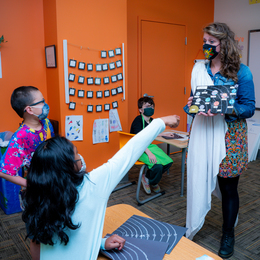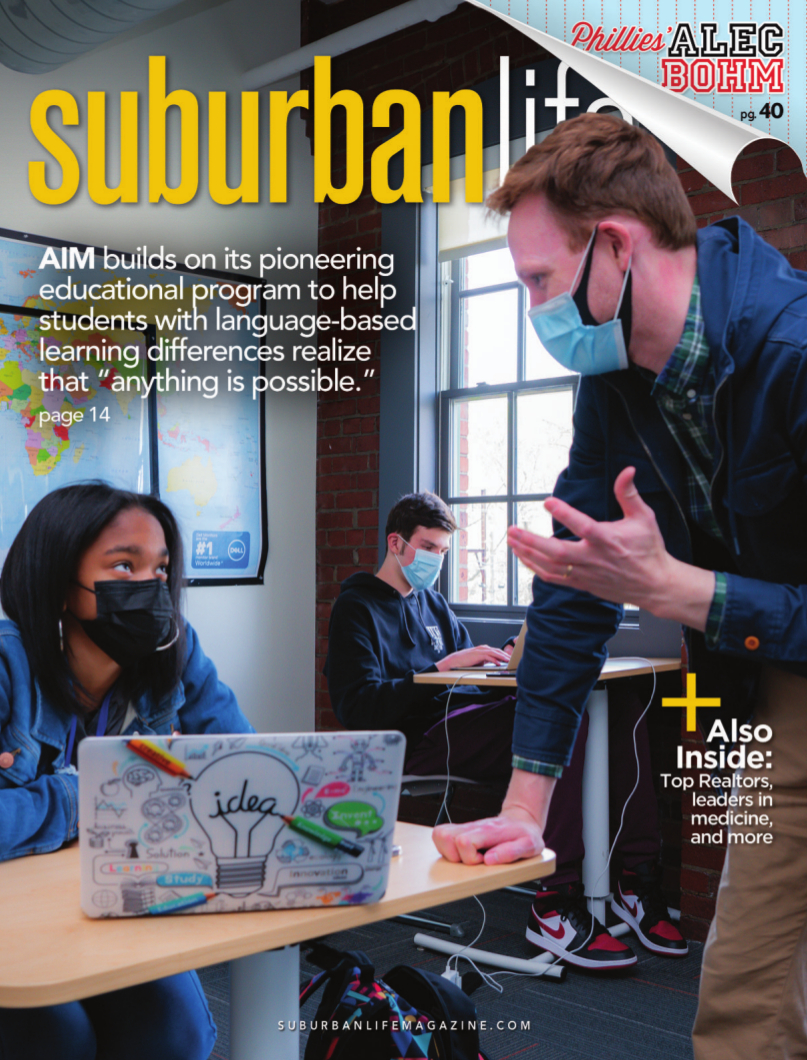
A New Vision for Education
AIM builds on its pioneering educational program to help students with language-based learning differences realize that “anything is possible.”
Nancy Blair and Pat Roberts had an ambitious goal when they cofounded a school in 2006, in a former Catholic school in Manayunk. They sought to create an innovative and supportive environment for children with language-based learning differences (LD) such as dyslexia, dysgraphia, and dyscalculia, with an educational model built on personalized and evidence-based instruction.
In the 15 years since Blair and Roberts breathed life into their creation, AIM Academy, now located right on the border separating city from suburbs, has become the Philadelphia area’s largest LD school for children in grades one through 12. More so, AIM has become known as a pioneer of sorts, with a groundbreaking curriculum rooted firmly in neuroscience and literacy research. The curriculum all but assures that every AIM Academy graduate possesses the foundational skills needed to flourish in the next phase of their education and beyond.
“Foundational language skills are critical to learning,” says Tina Zampitella, AIM Academy’s Coordinator of Curriculum and Instructional Leaders and Teacher Training, as well as a math teacher in the lower school. “All students learn more effectively when they feel safe, valued, and known, and when they have opportunities to express themselves and explore who they are. That’s why we’re so intentional about taking the time to develop a relationship with each student.”
Zampitella cites AIM’s integrated literacy model, built around six instructional core components—assessment, oral language, word recognition, comprehension, writing, and interactive humanities—and other best practices that evolve along with the science of learning. Specialized literacy programs such as the Wilson Reading System® help AIM students acquire the decoding and encoding skills needed to read and write effectively, while small-group instruction prevents any student from falling through the cracks.
“We have a student-to-teacher ratio of 6:1 in lower school reading, writing, math, and Wilson classes, and our students tend to learn best in homogenous groups that are based on in-depth assessments,” Zampitella adds. “Currently, for the 86 students in the lower school, or grades one through five, we have 26 Wilson groups and 18 math groups. By keeping these numbers low, teachers are able to provide differentiated instruction to make sure each student’s needs are being met.”
It may come as a surprise that most teachers, regardless of where they went to college or earned advanced degrees, do not receive the training needed to effectively teach the fundamentals of language. Zampitella says that’s why tools such as the Wilson Reading System and AIM’s new teacher training courses called AIM Pathways are so essential.
“I learned more about the English language by teaching students through Wilson than I did doing anything else in my career,” she adds. “I have two master’s degrees in reading, but I didn’t have access to the foundational knowledge required to teach students [with learning differences] how to read until I came to AIM.”
AIM’s unique integrated literacy model has the potential to benefit all students, not just those who learn differently. In its quest to improve outcomes for as many students as possible, the organization’s AIM Institute for Learning & Research has developed an online professional-development platform, AIM Pathways, with coursework that strives to help schools and educators throughout the region and across the country prioritize and improve literacy instruction.
Anna Shurak attests to the program’s value. As the executive director of Teach for America Philadelphia, Shurak aims to help her organization’s corps members—teachers and administrators alike—better serve students in marginalized and under-resourced communities. She cites a 2019 report from the National Assessment of Educational Progress, which shows that only 34 percent of fourth-grade public school students performed at or above proficiency level in reading. The disruption caused by the pandemic has worsened matters, especially in underserved communities. Shurak believes AIM Pathways can help fill the void.
“What we know in training our teachers is that they need the essentials to fill the opportunity gap, make up for lost learning, and catapult the potential of students,” she says. “Teachers have to be trained in the best and most efficient ways possible. AIM Pathways unlocks that potential in a way that teachers are not exposed to through their traditional undergraduate training.”
Shurak has seen firsthand how prioritizing literacy can change a student’s life. She believes tools such as AIM Pathways can help more students master the foundational skills of reading and writing, and thereby come to the realization that “anything is possible.”
“What a phenomenal institution AIM is,” says Shurak. “They have taken what works in a private educational environment and used those learnings to provide access and opportunities to Teach for America and other schools and partners across the city and the country. Everyone talks about bridging the divide, a need that can’t be underscored enough, but they’re walking the walk on a daily basis.”
AIM Academy
1200 River Road
Conshohocken, PA 19428
(215) 483-2461
For more information on the AIM Institute for Learning & Research, visit institute.aimpa.org.
Photography by Jody Robinson
Published (and copyrighted) in Suburban Life magazine, April 2021.



